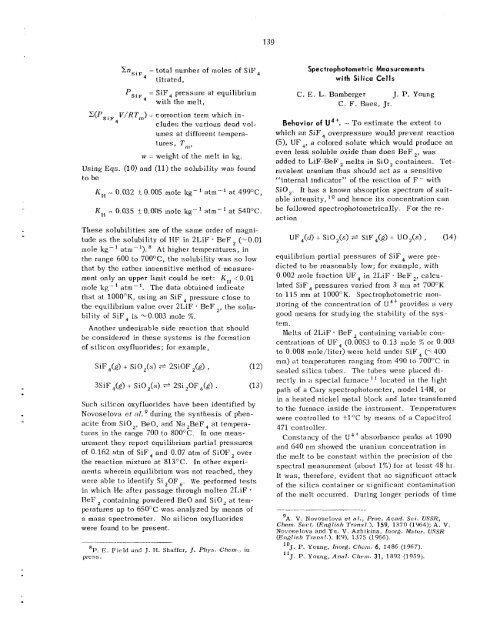ORNL-4191 - the Molten Salt Energy Technologies Web Site
ORNL-4191 - the Molten Salt Energy Technologies Web Site
ORNL-4191 - the Molten Salt Energy Technologies Web Site
You also want an ePaper? Increase the reach of your titles
YUMPU automatically turns print PDFs into web optimized ePapers that Google loves.
XnSi,, = total number of moles of SiF,<br />
titrated,<br />
pSip4 = SiF, pressure at equilibrium<br />
with <strong>the</strong> melt,<br />
.?;(f'Sip4V//RTm) - correction term which in-<br />
cludes <strong>the</strong> various dead vol-<br />
umes at different iempera-<br />
lures, Tm,<br />
w : weight of <strong>the</strong> melt in kg.<br />
IJsing Eqs. (10) and (11) <strong>the</strong> solubility was found<br />
to be<br />
K, : 0.032 t 0.005 mole kg-' atm-' at 499"C,<br />
K, = 0.035 i0.005 mole kg-' atm-' at 540T.<br />
These solubilities are of <strong>the</strong> same order of magni-<br />
tudc as <strong>the</strong> solubility of HF in 2LiF * BeF, (-0.01<br />
mole kg- atm '). ' At higher temperatures, in<br />
<strong>the</strong> range 600 to 70OoC, <strong>the</strong> solubility was so low<br />
that by <strong>the</strong> ra<strong>the</strong>r insensitive method of measure-<br />
ment only an upper limit could be set: K, .:0.01<br />
mole kg - atm- '. The data obtained indicate<br />
that at 1000"K, using an SiF, pressure close to<br />
<strong>the</strong> equilibrium value over 2LiF * BeF , <strong>the</strong> solu-<br />
bility of SiF, is -0 003 mole %.<br />
Ano<strong>the</strong>r undesirable side reaction that should<br />
bc considered in <strong>the</strong>se systems is <strong>the</strong> formation<br />
of silicon oxyfluorides; for example,<br />
Six;,(&) t SiO,(s) 2SiOF ,(g) , (1 2)<br />
3SiF 4(g) t SiO,(s) * 2Si ,OF ,(g) . (13)<br />
Such silicon oxyfluorides have been identified by<br />
Novoselova et d. during <strong>the</strong> syn<strong>the</strong>sis of phenacite<br />
from Si02, BeO, and Na,BeF, at ternperatures<br />
in <strong>the</strong> range 700 to 800°C In one meas-<br />
urement <strong>the</strong>y report equilibrium partial pressures<br />
of 0 162 atm of SiF, and 0.07 atm of SiOF, over<br />
<strong>the</strong> reaction mixture at 813cC. In o<strong>the</strong>r experi-<br />
mrnls wherein equilibrium was not reached, <strong>the</strong>y<br />
were able to identify Si,OF,. We performed tests<br />
in which He aftel pnssage through molten 2LiF *<br />
ReF, containing powdered Be0 and SiO, clt tern-<br />
peratures up to 650°C was analyzed by means of<br />
a mass spectrometer. No silicon oxyfluorides<br />
were found to be present.<br />
%. E. Field and J. H. Shaffer, J. P21ys. Chem., in<br />
press.<br />
139<br />
Specfrophotometric Measurements<br />
with Silica Cells<br />
C. E. L. Bamberger J. P. Young<br />
C. F. F3aes, Jr.<br />
Behavior of u4+. - To estimate <strong>the</strong> extent to<br />
which an SiF overpressure would prevent reaction<br />
(3, UF,, a colored solute which would produce an<br />
even less soluble oxide than does BeF,, was<br />
added to LiF-BeF , melts in SiO, containers. 'retravalent<br />
uranium thus should act as a sensitive<br />
"internal indicator'' of <strong>the</strong> reaction of F- with<br />
SO,. It has a known absorption spectrum of suitable<br />
intensity, '' and hence its concentration can<br />
be followed spectrophotometrically. For <strong>the</strong> react<br />
ion<br />
UF,(d) -t Si02(s) + SiF,(g) t I.JO,(s) , (14)<br />
equilibrium partial pressures of SiF, were predicted<br />
to he reasonably low; for example, with<br />
0.002 mole fraction Up-, in 2LiF = BeF,, calculated<br />
SiF, pressures varied from 3 mm at 700°K<br />
to 115 mtri at 1000°K. Spectrophotometric monitoring<br />
of <strong>the</strong> concentration of U4' provides a very<br />
good means for studying <strong>the</strong> stability of <strong>the</strong> system.<br />
Melts of 2LiF BeF containing variable concentrations<br />
of UF, (0.0053 to 0.13 mole % OK 0.003<br />
to 0.008 mole/liter) were held under Sip,# (--400<br />
mm) at temperatures ranging from 490 to 70OoC in<br />
sealed silica tubes. The tubes were placed directly<br />
in a special furnace" located in <strong>the</strong> light<br />
path of a Cary spectrophotometer, model 141, or<br />
in a heated nickel metal block and later transferred<br />
to <strong>the</strong> furnace inside <strong>the</strong> instrument. 'Temperatures<br />
were controlled to floe by means of a Capacitrol<br />
471 controller.<br />
Constancy of <strong>the</strong> U4+ absorbance peaks at 1090<br />
and 640 nm showed <strong>the</strong> uranium concentration in<br />
<strong>the</strong> melt to be constant. within <strong>the</strong> precision of thc<br />
spectral measurement (about 17%) for at least 43 hr.<br />
It was, <strong>the</strong>refore, evident. that no significant attack<br />
of <strong>the</strong> silica container Or significant contamination<br />
of <strong>the</strong> melt occurred. During longer periods of time<br />
V. Novoselova et ol., Proc. Acad. ~ci.<br />
9 ~ .<br />
USSR,<br />
Chern. Sect. (Eriplish Transl.), 159, 1370 (1964); A. V.<br />
Novoselova and Yu. V. Azhikina, Iziorg. Mater. USSR<br />
(English Transl.), 1(9), 1375 (1966).<br />
"J. P. Young, Inorg. Cherri. 6, 1486 (1967).<br />
"J. P. Yourig, Anal. Chprn. 31, 1592 (1959).



![Review of Molten Salt Reactor Physics Calculations [Disc 2]](https://img.yumpu.com/21979492/1/190x247/review-of-molten-salt-reactor-physics-calculations-disc-2.jpg?quality=85)












